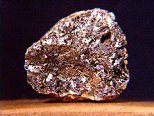 Discovery Information Discovery Information |
| Who: Known to the ancients. |
|
 Name Origin Name Origin |
| Greek: anti (opposed) monos (solitude). |
|
 Sources Sources |
| Found in stibnite (Sb2S3) and in valentinite (Sb2O3). The majority of Antimony comes from China. Even though this element is not abundant, it is found in over 100 mineral species. |
|
 Uses Uses |
| Used to harden lead alloys. Also used in solder, bearings, lead batteries, mascara, infrared detectors, diodes, plastics and chemicals. |
|
 Notes Notes |
| Antimony and many of its compounds are toxic. Clinically, antimony poisoning is very similar to arsenic poisoning. In small doses, antimony causes headache, dizziness, and depression. Larger doses cause violent and frequent vomiting, and will lead to death in few days. |
| Estimates of the abundance of antimony in the Earth's crust range from 0.2 to 0.5 ppm. |


 Discovery Information
Discovery Information Name Origin
Name Origin Sources
Sources Uses
Uses Notes
Notes Images
Images
